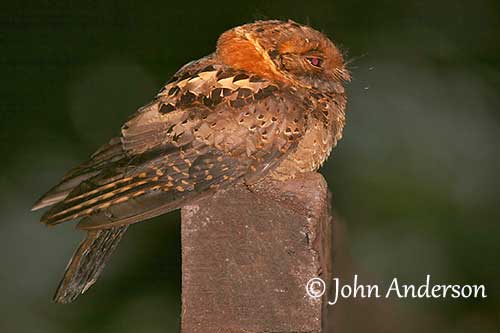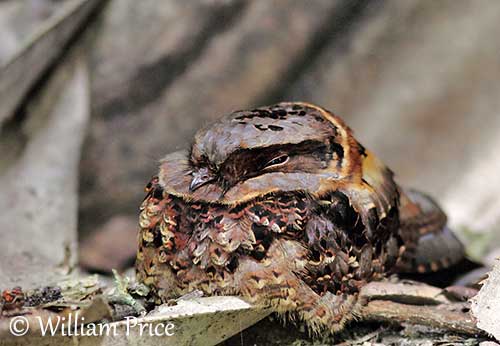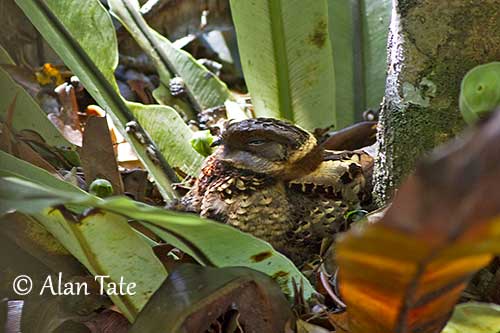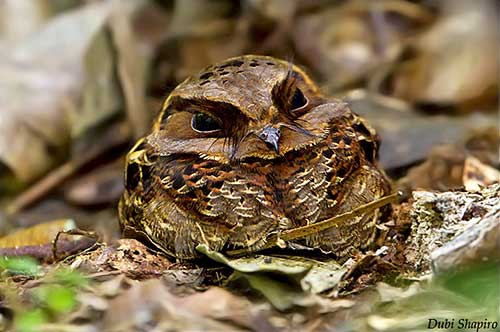
PROTECTION / THREATS / STATUS:
The Collared Nightjar is usually rare throughout the range, but its secretive habits make the bird difficult to observe. However, it may be common in suitable forested habitats.
This species is vulnerable to habitat destruction and hunting pressure, and the population is suspected to be declining.
But currently, the Collared Nightjar is evaluated as Least Concern.
Fr: Engoulevent à nuque rousse
Ang: Collared Nightjar
All: Halsband-Nachtschwalbe
Esp: Chotacabras Acollarado
Ita: Succiacapre dal collare
Nd: Gekraagde Nachtzwaluw
Sd: rödnackad nattskärra
Mal: Matoriandro, tataro, Tataroala
Photographers:
John Anderson
John Anderson Photo Galleries
William Price
PBase-tereksandpiper & Flickr William Price
Dubi Shapiro
Dubi Shapiro Photo Galleries
Alan & Ann Tate
AA Bird Photography
Text by Nicole Bouglouan
Sources :
HANDBOOK OF THE BIRDS OF THE WORLD Vol 5 by Josep del Hoyo-Andrew Elliott-Jordi Sargatal - Lynx Edicions - ISBN: 8487334253
NIGHTJARS - A Guide to Nightjars and Related Nightbirds – Nigel Cleere and Dave Nurney - Yale University Press - First Edition (August 11, 1998) - ISBN 10: 0300074573 / ISBN 13: 9780300074574
The Birds of Africa: Volume VIII: The Malagasy Region: Madagascar Par Roger Safford,Frank Hawkins
ScienceBlogs – Nightjars of Madagascar
Birds of Madagascar and the Indian Ocean Islands Par Roger Safford,Adrian Skerrett,Frank Hawkins
African Bird Club - Photospot: Collared Nightjar Caprimulgus enarratus
Collared Nightjar
Gactornis enarratus
Caprimulgiformes Order – Caprimulgidae Family
INTRODUCTION:
The Collared Nightjar was formerly included in the genus Caprimulgus, but it differs by some morphological features and unusual behaviour. The species appears to be silent and no song has ever been recorded.
It is endemic to Madagascar where it occurs in the eastern humid forests, although some other types of habitats have been recently found in the western part. It can be seen up to 1800 metres of elevation.
The Collared Nightjar is vulnerable to habitat destruction through deforestation and hunting pressure. It is rather rare or uncommon throughout the range, but it is not globally threatened.
DESCRIPTION OF THE BIRD:
Biometrics:
Length: 24 cm
Weight: M: 48 g – F: 57 g
The Collared Nightjar has greyish-brown upperparts with blackish-brown spotting (spots have chestnut edges). We can see a conspicuous, broad, rufous nuchal collar with sharp buff band above. Wing-coverts and scapulars are similar to the upperparts, also with bold spots.
On the underparts, we can see a tawny-buff band around the lower part of the throat. The underparts are brownish with conspicuous blackish-brown, edged chestnut spots. However, belly and flanks are rather streaked than spotted.

This species lacks the typical white wing markings, and the outermost rectrices show narrow white tips. It is darker and plainer than the Madagascar Nightjar.
Male and female are similar.
The bill is blackish or pinkish-grey with black tip. The eyes are dark brown. Legs and feet are dark brown or pinkish-grey.
The juvenile is paler and buffier than adults. The nuchal collar is dark, and there is a row of large dark spots across the wing coverts.
RANGE:
The Collared Nightjar is found in N and E Madagascar, with recent records in W.
HABITAT:
The Collared Nightjar frequents humid dense forest in lowland and lower montane forest, but it can be found in humid, transitional patches too. It is mainly recorded from sea-level to 800-900 metres, but it may occur higher, up to 1500 and 1800 metres of elevation. This species has been recently mentioned in brush forest and mangroves around Morondava.
CALLS AND SONGS:
The Collared Nightjar’s voice is unknown and currently not described. However, if the nest-site is threatened, the adult produces soft “kow” or “keeow”. The threat displays are accompanied by loud hisses “tsrrr”. The young birds utter soft “chic” notes.

The Collared Nightjar differs from other nightjars by its nesting behaviour. This species is known to nest in epiphytic ferns on tree trunks, or in the crown of other fern species, usually between 1,5 and 2 metres above the ground. It often nests in forest interior, but also near clearings. Other nightjar species usually lay the eggs directly on the ground.
The courtship displays occurs usually in the air. As this species was formerly included in Caprimulgus genus, it probably flies with the wings in V shape above the body and producing clapping noises. We can suggest that the rufous nuchal collar is enhanced by adapted postures, like the conspicuous spots of both wing-coverts and scapulars.
The Collared Nightjar is probably sedentary and no movements have been reported.
Nightjars are usually very good fliers. They fly during the courtship displays and while hunting and hawking flying insects.
REPRODUCTION OF THIS SPECIES:
The breeding season occurs mainly in October/November. The Collared Nightjar nests close to forest tracks or clearings. The nest-site is established within two metres above the ground, often in epiphytic fern on tree trunk. No nest built.
The female lays two glossy white eggs with faint pinkish-brown wash. If the incubating adult is alarmed, it may perform threat displays during which it “inflates” with the bill wide open, while producing loud hisses “tsrrr”. It also performs injury-feigning distraction display to lead predators away from the nest-site. Once feathered, the chicks are able to reach low branches to escape a danger.
This species may produce two broods per season.

BEHAVIOUR IN THE WILD:
The Collared Nightjar feeds mainly on medium-sized insects caught above or below the canopy by hawking. It also performs repeated sallies from emergent bare branches at forest edge or in clearing, over streams or along forest tracks.
It rushes forwards over a few metres to catch a flying prey and returns to its perch. Unlike other nightjars, the Collared Nightjar appears to hunt only within the forest.
The Collared Nightjar is found alone or in pairs, usually on the forest floor where the cryptic plumage makes the bird almost invisible. Both mates are lying against each other, similar to a strange two-headed bird.
This species has crepuscular and nocturnal habits, and it rests during the day, well-hidden on the ground between roots or among the leaf litter. The roost sites are often used during several days, and the birds roost in pairs outside breeding season. They are also observed on low branches after a short-distance flight.
